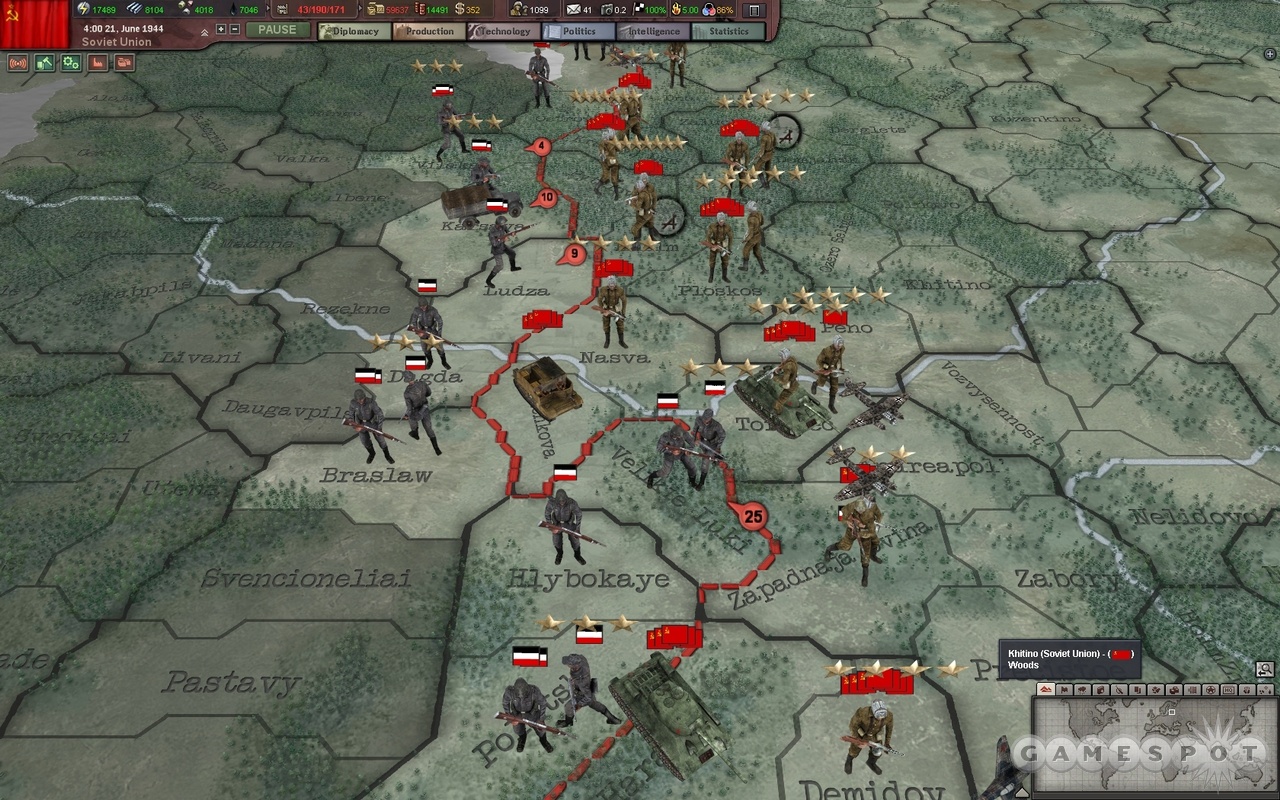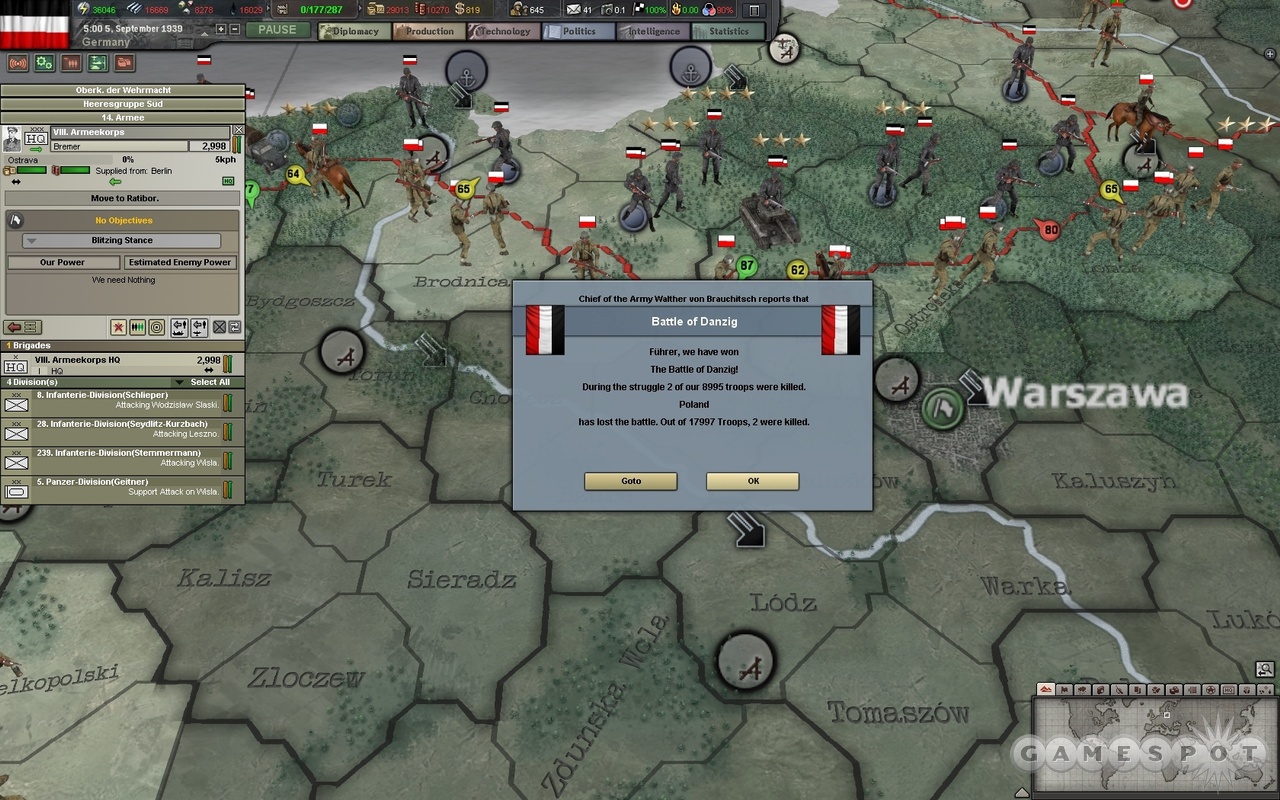Flattening the learning curve is as much the focus of Hearts of Iron III as the Second World War, which the game depicts. Paradox Entertainment's third grand strategy go-round with Winston, Franklin, Adolf, and Joseph is a thorough reenvisioning of its predecessors, maintaining all of the game's complexities while distilling the hardcore micromanagement through a mostly superb interface. Although you still spend a great deal of time sifting through reams of data, it's now much easier to cut to the chase. So instead of getting bogged down by the minutiae of war economics, such as oil production in the Caucasus, you can head right for the much more satisfying aspects of WWII. Even with some technical glitches, this deeply engaging game is the most approachable and user-friendly that Paradox has ever released out of the box.

With all that said, Hearts of Iron III remains a serious real-time strategy game that is as intricate as the design of a Persian rug. Like its cousins Europa Universalis and Crusader Kings, Hearts of Iron III isn't a game that you will figure out, let alone master, in a couple of hours. The basic structure of the game is stock standard when it comes to Paradox's grand strategy lineup. The design blends the first two releases in the Hearts of Iron series with the 3D map and revamped interface of 2007's Europa Universalis III. So even though you get to look at a newfangled world map with 3D soldiers, tanks, ships, and planes moving about, the core of the game is still centered on taking control of a nation during the WWII era. Matches can be played solo or multiplayer over a LAN or the Net if you've got a lot of patience for the time it can take to finish such an undertaking. There are seven default starting dates that stretch from the nervous peace of 1936 to the beginning of the end in 1944. This lets you run through the whole 12-plus years of global insanity or pick your spot and replay history from such key moments as the German invasion of Poland or the aftermath of the Japanese bombing of Pearl Harbor. Success is achieved by outlasting foes and accumulating the most victory points by the time the clock runs out and the war era comes to a close.
As is typical of Paradox productions, the depth is mind-blowing. Just about everything you could imagine is modeled here. Democracy, fascism, and communism go toe-to-toe on the world stage, both diplomatically and on the battlefield, courtesy of the machinations of the Allies, Axis, and Comintern powers. Nations are fully stocked with leaders, including cabinet ministers and generals, all with their own skills and personalities. Laws are passed and national priorities are set that can mirror history or send things off on wild tangents. Some 15,000 provinces are ready for you to micromanage, with their traits being modeled right down to such natural resources as food and oil, as well as economic builders, such as factories, that contribute to industrial capacity. Armies, navies, and air forces are built from the ground up, then sent into battle at your command. Technology is researched to build better military hardware and improve economic production at home. Spies steal information from rivals and indulge in sabotage. Even weather fronts now roll across the continents, affecting military moves and economic production.
OK, all that may not sound like a tremendous amount of fun to wrangle with--especially if you remember the micromanagement hell of the first Hearts of Iron. But Paradox has made huge strides here. Much like Europa Universalis III, in Hearts of Iron III, you can choose how involved you want to be running the ship of state. Just about everything can be automated. Resources? Check. Diplomacy? Check. Spying? Check. Army building? Check. Fighting? Check. Yet this doesn't mean that the game runs on autopilot. Even if you cede nitty-gritty control to the CPU, you still direct things from on high, setting the priorities that your computer minions then carry out in a very intelligent fashion. Going into battle has been streamlined the most. Military matters are now sensibly structured via layers of headquarters. This enables you to take control of field-level HQs and direct battles manually or move up steps and give orders for specific battle theaters that direct all troops under this command to do your bidding. For example, in the early stages of the war in 1939 and early 1940, you can order Rommel's HQ to take Paris. This essentially mobilizes the entire Western front into action because all of the units under his command will then start pushing forward. No muss, no fuss.
You can take direct control of army groups when necessary, of course, although the artificial intelligence seems to do a superb job of smartly carrying out your directives. The only oddity here has to do with battle casualties; they sometimes seem impossibly low, with two people dying in a showdown among 20,000 infantry. There is also more back-and-forth with your underlings. When you issue an order, the HQ in question immediately kicks back a request for units it thinks are needed to accomplish the task, allowing you to tailor production accordingly. Tech research and production are similar, providing feedback to your efforts via bonuses that accrue the more you specialize. If you research and then crank out a lot of armor, you soon find that everything speeds up as your men gain greater experience and expertise.
All in all, this system flips the usual grand strategy formula on its head, in that you can now first focus on the big picture instead of getting so bogged down in micromanagement minutiae that you scramble back and forth with little consideration for the grand scheme of things. Only tech and production remain daunting because the menu screens for each are so loaded with numbers that you soon feel like a junior accountant at tax time. Yet even with this problem, you get the feeling that this is what Hearts of Iron was supposed to be all along. Now, you're actually in control of the game, not a slave to it. As a result, it's tough to stop playing because it's so easy to experiment with different approaches and muck up history. It's a blast to run through campaigns simply to see the many fascinating ways that they diverge from what happened in real life. One game might stick to the script with the single exception of the Netherlands signing on with the UK in 1938 to present a more united front against Hitler. Yet, the next might see something wacky, like Argentina battling the US in Central America, the French holding along the Maginot Line, or Switzerland joining the Allies and going on the offensive. Events never stray very far from the plausible, either, which makes games captivating for alt-history fans.
There are prices to be paid, however. This is one slow-moving war even when played on the most modern gaming rig. Background calculations seem to be so numerous that the game frequently lags. This is most annoying in the early stages of grand campaign games that begin in 1936 because the dull prewar years are stretched out. Graphical hitches are also common, particularly after the shooting starts. Because Hearts of Iron III isn't a twitch arcade game, this generally means that you just wind up scrolling the map too far and end up in Canada instead of the UK. But it's still frustrating. Slowdowns are accentuated when playing with 3D troop models, forcing you to switch to wargame counters for a smoother experience. Again, this isn't a big deal because the game has a strong wargame vibe anyways, though it still underlines the need for a patch. Another niggling issue is front and center when you start up the game. The tuition text is strewn with typos and translation errors, which makes it hard to sit through the otherwise amusing walk-through of the game's features by Hitler. Just about any native English speaker would be able to correct these glaring mistakes in about 15 minutes, so it's sad to see that Paradox let these go before shipping the game.
For once, allowing for greater automation has improved a strategy game. Reducing micromanagement increases the interaction you have with your forces in Hearts of Iron III because you really feel like a political leader instead of a drone shuffling troops across a map. This is still tailored for experienced strat heads and wargamers with a lot of patience, but the game is more accessible than either of its predecessors and a great jumping-on point for new players who want to make the leap into a grand strategy epic.
